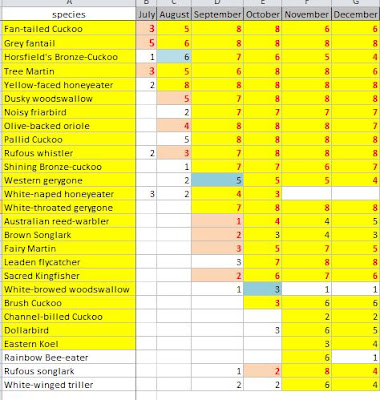Going with a friend for a morning's birding in the Bungendore area we drove along the road from Hoskinstown. (No luck with Banded Lapwings.) As we passed the entrance to Mills Cross we spotted a Cattle Egret, still with optimism about breeding.
This is a blog about birds seen in the locality of Carwoola in the State of NSW Australia. I suggest readers begin with the Background page (earliest post).
Tuesday, November 24, 2015
Sunday, November 1, 2015
October 2015
October 2015
The most excitement this month a Banded Lapwing chick being seen on the Hoskinstown site. It was only seen on one occasion. The number of birds of the species has varied somewhat over the month with 12 being seen mid-month but only 6th when I swung by on the 31st. I suspect this means the birds were simply out of site- too far away from the road; hunkered down behind one of the many lumps of bulls**t, or below the rim of a dam in the main paddock.
The swamp on the Hoskinstown Plain still has some moisture, with Black-winged Stilts, up to 5 White-necked Herons and 2 Royal Spoonbills being seen at various times.
Other less common birds have been a Red-capped Robin spotted on Whiskers Creek Rd and a Superb Lyrebird seen off Wanna
Wanna Rd. The least common bird heard
was an Australian Owlet–nightjar which woke me at 4am one morning.
Overall we recorded 108 species in the area in the month, which is 8 more than September 2015 and 6 more than October 2014.
With the exception of January we have - like the children of Lake Woebegone MN - been above average.every month this year.
While there is much more pink than blue in that graphic the determination of 'expected first month' is a tad speculative. However I think it safe to say that the migrants were not late this year!
As always thanks to the observers who have provided reports to me for the month. These have covered sites in Widgiewa Rd, Wanna Wanna, Bowen Street, Hoskinstown Plain and Village, Captains Flat Rd and Molonglo Valley.
Summer migrants are highlighted in orange, and Winter migrants in blue.
1 Waterbirds (pt 1): (pt 2); (Pt 3); (Pt 4): Musk Duck; Black Swan; Australian Shelduck; Australian Wood Duck; Grey Teal; Pacific Black Duck; Hardhead; Australasian Grebe; Little Black Cormorant; Little Pied Cormorant; White‑necked Heron; White‑faced Heron; Straw-necked Ibis; Royal Spoonbill; Eurasian Coot; Black-winged Stilt; Masked Lapwing; Banded Lapwing
2 Birds of Prey: Black-shouldered Kite; Wedge-tailed Eagle; Nankeen Kestrel; Brown Falcon; Australian Hobby; Peregrine Falcon.
3 Parrots and Relatives: Yellow-tailed Black-Cockatoo; Gang‑gang Cockatoo; Galah; Sulphur‑crested Cockatoo; Australian King‑parrot; Crimson Rosella; Eastern Rosella; Red-rumped Parrot
4 Kingfishers and other non-songbirds (Pt 1) (Pt 2) (Pt 3):Stubble Quail; Rock Dove; Common Bronzewing; Crested Pigeon; Tawny Frogmouth; Australian Owlet-nightjar; Horsfield's Bronze‑Cuckoo; Shining Bronze‑cuckoo; Pallid Cuckoo; Fan‑tailed Cuckoo; Brush Cuckoo;Laughing Kookaburra; Sacred Kingfisher; Dollarbird; Superb lyrebird
5 Honeyeaters: Eastern Spinebill; Yellow-faced Honeyeater; White-eared Honeyeater; Noisy Miner; Red Wattlebird; New Holland Honeyeater; White-fronted Chat; Brown‑headed Honeyeater; White-naped Honeyeater; Noisy Friarbird
6 Flycatchers and similar species: Rufous Whistler; Grey Shrike-thrush; Grey Fantail; Willie Wagtail; Leaden Flycatcher; Magpie-lark; Scarlet Robin; Red‑capped Robin, Flame Robin; Eastern Yellow Robin; Welcome Swallow; Fairy Martin; Tree Martin
7 Thornbills, Finches and similar species (Pt 1) (Pt 2): Superb Fairy-wren; White-browed Scrubwren; Speckled warbler; Weebill; Western Gerygone; White-throated Gerygone; Striated Thornbill; Yellow‑rumped Thornbill; Buff‑rumped Thornbill; Brown Thornbill; Spotted Pardalote; Striated Pardalote; Silvereye; Double‑barred Finch; Red‑browed Finch; Diamond Firetail; House Sparrow; European Goldfinch
8 Other, smaller birds: White-throated Treecreeper; Black-faced Cuckoo-shrike; White‑-winged Triller; Olive‑backed Oriole; Dusky Woodswallow;Skylark; Golden-headed Cisticola; Australian Reed-warbler; Rufous Songlark; Brown Songlark; Common Blackbird; Common Starling; Mistletoebird; Australasian Pipit;
9 Other, larger birds: Satin Bowerbird; Grey Butcherbird; Australian Magpie; Pied Currawong; Grey Currawong; Australian Raven; Little Raven; White-winged Chough
2 Birds of Prey: Black-shouldered Kite; Wedge-tailed Eagle; Nankeen Kestrel; Brown Falcon; Australian Hobby; Peregrine Falcon.
3 Parrots and Relatives: Yellow-tailed Black-Cockatoo; Gang‑gang Cockatoo; Galah; Sulphur‑crested Cockatoo; Australian King‑parrot; Crimson Rosella; Eastern Rosella; Red-rumped Parrot
4 Kingfishers and other non-songbirds (Pt 1) (Pt 2) (Pt 3):Stubble Quail; Rock Dove; Common Bronzewing; Crested Pigeon; Tawny Frogmouth; Australian Owlet-nightjar; Horsfield's Bronze‑Cuckoo; Shining Bronze‑cuckoo; Pallid Cuckoo; Fan‑tailed Cuckoo; Brush Cuckoo;Laughing Kookaburra; Sacred Kingfisher; Dollarbird; Superb lyrebird
5 Honeyeaters: Eastern Spinebill; Yellow-faced Honeyeater; White-eared Honeyeater; Noisy Miner; Red Wattlebird; New Holland Honeyeater; White-fronted Chat; Brown‑headed Honeyeater; White-naped Honeyeater; Noisy Friarbird
6 Flycatchers and similar species: Rufous Whistler; Grey Shrike-thrush; Grey Fantail; Willie Wagtail; Leaden Flycatcher; Magpie-lark; Scarlet Robin; Red‑capped Robin, Flame Robin; Eastern Yellow Robin; Welcome Swallow; Fairy Martin; Tree Martin
7 Thornbills, Finches and similar species (Pt 1) (Pt 2): Superb Fairy-wren; White-browed Scrubwren; Speckled warbler; Weebill; Western Gerygone; White-throated Gerygone; Striated Thornbill; Yellow‑rumped Thornbill; Buff‑rumped Thornbill; Brown Thornbill; Spotted Pardalote; Striated Pardalote; Silvereye; Double‑barred Finch; Red‑browed Finch; Diamond Firetail; House Sparrow; European Goldfinch
8 Other, smaller birds: White-throated Treecreeper; Black-faced Cuckoo-shrike; White‑-winged Triller; Olive‑backed Oriole; Dusky Woodswallow;Skylark; Golden-headed Cisticola; Australian Reed-warbler; Rufous Songlark; Brown Songlark; Common Blackbird; Common Starling; Mistletoebird; Australasian Pipit;
9 Other, larger birds: Satin Bowerbird; Grey Butcherbird; Australian Magpie; Pied Currawong; Grey Currawong; Australian Raven; Little Raven; White-winged Chough
Subscribe to:
Comments (Atom)








